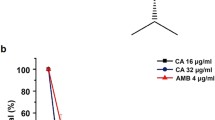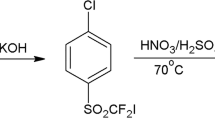Abstract
The Caenorhabditis elegans model can be used to study Candida albicans virulence and host immunity, as well as to identify plant-derived natural products to use against C. albicans. Thymol is a hydrophobic phenol compound from the aromatic plant thyme. In this study, the in vitro data demonstrated concentration-dependent thymol inhibition of both C. albicans growth and biofilm formation during different developmental phases. With the aid of the C. elegans system, we performed in vivo assays, and our results further showed the ability of thymol to increase C. elegans life span during infection, inhibit C. albicans colony formation in the C. elegans intestine, and increase the expression levels of host antimicrobial genes. Moreover, among the genes that encode the p38 MAPK signaling pathway, mutation of the pmk-1 or sek-1 gene decreased the beneficial effects of thymol’s antifungal activity against C. albicans and thymol’s maintenance of the innate immune response in nematodes. Western blot data showed the level of phosphorylation of pmk-1 was dramatically decreased against C. albicans. In nematodes, treatment with thymol recovered the dysregulation of pmk-1 and sek-1 gene expressions, the phosphorylation level of PMK-1 caused by C. albicans infection. Therefore, thymol may act, at least in part, through the function of the p38 MAPK signaling pathway to protect against C. albicans infection and maintain the host innate immune response to C. albicans. Our results indicate that the p38 MAPK signaling pathway plays a crucial role in regulating the beneficial effects observed after nematodes infected with C. albicans were treated with thymol.











Similar content being viewed by others
References
Mayer FL, Wilson D, Hube B. Candida albicans pathogenicity mechanisms. Virulence. 2013;4(2):119–28.
Berman J, Sudbery PE. Candida Albicans: a molecular revolution built on lessons from budding yeast. Nat Rev Genet. 2002;3(12):918–30.
Kobayashi SD, Cutler JE. Candida albicans hyphal formation and virulence: is there a clearly defined role. Trends Microbiol. 1998;6(3):92–4.
Irazoqui JE, Urbach JM, Ausubel FM. Evolution of host innate defence: insights from Caenorhabditis elegans and primitive invertebrates. Nat Rev Immunol. 2010;10(1):47–58.
Kim DH, Ausubel FM. Evolutionary perspectives on innate immunity from the study of Caenorhabditis elegans. Curr Opin Immunol. 2005;17(1):4–10.
Kurz CL, Ewbank JJ. Caenorhabditis elegans: an emerging genetic model for the study of innate immunity. Nat Rev Genet. 2003;4(5):380–90.
Means TK, et al. Evolutionarily conserved recognition and innate immunity to fungal pathogens by the scavenger receptors SCARF1 and CD36. J Exp Med. 2009;206(3):637–53.
Mylonakis E, Casadevall A, Ausubel FM. Exploiting amoeboid and non-vertebrate animal model systems to study the virulence of human pathogenic fungi. PLoS Pathog. 2007;3(7):e101.
Pukkila-Worley R, Mylonakis E. From the outside in and the inside out: antifungal immune responses in Caenorhabditis elegans. Virulence. 2010;1(3):111–2.
Pukkila-Worley R, Ausubel FM, Mylonakis E. Candida albicans infection of Caenorhabditis elegans induces antifungal immune defenses. PLoS Pathog. 2011;7(6):e1002074.
Aballay A, et al. Cranberry extract standardized for proanthocyanidins promotes the immune response of Caenorhabditis elegans to Vibrio cholerae through the p38 MAPK pathway and HSF-1. PLoS ONE. 2014;9(7):e103290.
Coleman JJ, et al. Antifungal activity of microbial secondary metabolites. PLoS ONE. 2011;6(9):e25321.
Tournu H, Serneels J, Van Dijck P. Fungal pathogens research: novel and improved molecular approaches for the discovery of antifungal drug targets. Curr Drug Targets. 2005;6(8):909–22.
Breger J, et al. Antifungal chemical compounds identified using a C. elegans pathogenicity assay. PLoS Pathog. 2007;3(2):e18.
Idnurm A, et al. Identification of antifungal compounds active against Candida albicans using an improved high-throughput Caenorhabditis elegans assay. PLoS ONE. 2009;4(9):e7025.
Chang W, et al. Retigeric acid B attenuates the virulence of Candida albicans via inhibiting adenylyl cyclase activity targeted by enhanced farnesol production. PLoS ONE. 2012;7(7):e41624.
Zhao LX, et al. Effect of tetrandrine against Candida albicans biofilms. PLoS ONE. 2013;8(11):e79671.
Coleman JJ, et al. Characterization of plant-derived saponin natural products against Candida albicans. ACS Chem Biol. 2010;5(3):321–32.
Falcone PM, et al. Evaluating in vitro antimicrobial activity of thymol toward hygiene-indicating and pathogenic bacteria. J Food Prot. 2007;70(2):425–31.
Braga PC, et al. Thymol inhibits Candida albicans biofilm formation and mature biofilm. Int J Antimicrob Agents. 2008;31(5):472–7.
Guo N, et al. Antifungal activity of thymol against clinical isolates of fluconazole-sensitive and -resistant Candida albicans. J Med Microbiol. 2009;58(Pt 8):1074–9.
Khan A, et al. Effect of two monoterpene phenols on antioxidant defense system in Candida albicans. Microb Pathog. 2015;80:50–6.
Brenner S. The genetics of Caenorhabditis elegans. Genetics. 1974;77(1):71–94.
Sun L, Liao K, Wang D. Effects of magnolol and honokiol on adhesion, yeast-hyphal transition, and formation of biofilm by Candida albicans. PLoS ONE. 2015;10(2):e0117695.
Sun LM, et al. Synergistic activity of magnolol with azoles and its possible antifungal mechanism against Candida albicans. J Appl Microbiol. 2015;118(4):826–38.
Larsen B, et al. Key physiological differences in Candida albicans CDR1 induction by steroid hormones and antifungal drugs. Yeast. 2006;23(11):795–802.
Sun L, et al. In vitro activities of retigeric acid B alone and in combination with azole antifungal agents against Candida albicans. Antimicrob Agents Chemother. 2009;53(4):1586–91.
He K-W, et al. Regulation of aging by unc-13 and sbt-1 in Caenorhabditis elegans is temperature-dependent. Neurosci Bull. 2009;25(6):335–42.
Wang D, Wang Y, Shen L. Confirmation of combinational effects of calcium with other metals in a paper recycling mill effluent on nematode lifespan with toxicity identification evaluation method. J Environ Sci (China). 2010;22(5):731–7.
Wang D, Xing X. Pre-treatment with mild UV irradiation suppresses reproductive toxicity induced by subsequent cadmium exposure in nematodes. Ecotoxicol Environ Saf. 2010;73(3):423–9.
Wu Q, et al. Association of oxidative stress with the formation of reproductive toxicity from mercury exposure on hermaphrodite nematode Caenorhabditis elegans. Environ Toxicol Pharmacol. 2011;32(2):175–84.
Li Y, et al. Transmissions of serotonin, dopamine, and glutamate are required for the formation of neurotoxicity from Al2O3-NPs in nematode Caenorhabditis elegans. Nanotoxicology. 2013;7(5):1004–13.
Wang D, Xing X. Pre-treatment with mild metal exposure suppresses the neurotoxicity on locomotion behavior induced by the subsequent severe metal exposure in Caenorhabditis elegans. Environ Toxicol Pharmacol. 2009;28(3):459–64.
Wang D, et al. Methods for creating mutations in C. elegans that extend lifespan. Biol Aging. 2013;1048:65–75.
Acknowledgments
This study was supported by the National Program during the 12th Five-year Plan Period, high ecological utilization for regional specialty resources (2012BAD36B01), Grants from the National Natural Science Foundation of China (No. 81302814), and Natural Science Foundation of Jiangsu Province (No. BK20130640).
Author information
Authors and Affiliations
Corresponding author
Ethics declarations
Conflict of interest
The authors declare that they have no conflict of interest.
Human and animal rights statement
All applicable international, national, and/or institutional guidelines for the care and use of animals were followed. All procedures performed in studies involving animals were in accordance with the ethical standards of the institution or practice at which the studies were conducted. This article does not contain any studies with human participants performed by any of the authors.
Informed consent
Informed consent was obtained from all individual participants included in the study.
Additional information
Chengjie Shu and Lingmei Sun have contributed equally to this work.
Rights and permissions
About this article
Cite this article
Shu, C., Sun, L. & Zhang, W. Thymol has antifungal activity against Candida albicans during infection and maintains the innate immune response required for function of the p38 MAPK signaling pathway in Caenorhabditis elegans . Immunol Res 64, 1013–1024 (2016). https://doi.org/10.1007/s12026-016-8785-y
Published:
Issue Date:
DOI: https://doi.org/10.1007/s12026-016-8785-y




